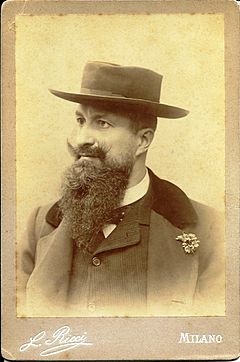Luigi Robecchi Bricchetti facts for kids
Quick facts for kids
Luigi Robecchi Bricchetti
|
|
|---|---|

Luigi Robecchi Bricchetti
|
|
| Born | 21 May 1855 Pavia
|
| Died | 31 May 1926 Pavia
|
| Nationality | Italian |
| Alma mater | Karlsruhe Institute of Technology |
| Children | Mabruc Robecchi Bricchetti |
| Relatives | Ercole Robecchi (father) Teresa Bricchetti (mother) |
| Scientific career | |
| Fields | Explorer, geographer, cartographer naturalist. |
Luigi Robecchi Bricchetti (born May 21, 1855 – died May 31, 1926) was an important Italian explorer. He was also a geographer, a mapmaker, and a naturalist. This means he studied nature and living things.
About Luigi Robecchi Bricchetti
Luigi Robecchi Bricchetti was born in Pavia, Italy. His father was Ercole Robecchi, a landowner. His mother was Teresa Brichetti, a seamstress. Luigi lived with his mother and used her last name for many years. Later, his father officially recognized him. In 1874, Luigi changed his name to Robecchi Bricchetti.
Luigi studied engineering at the University of Pavia. He continued his studies in Switzerland and Germany. He graduated from the Karlsruhe Institute of Technology.
He was interested in many subjects. These included people and cultures, geography, and animals. He was very good at languages, speaking German and Arabic fluently. Luigi also worked hard to fight against slavery in Africa.
He was a classic explorer from the 1800s. He brought many African objects and documents back to his home in Pavia. On his last trip to Africa in 1903, he helped a Somali woman and her son escape slavery. He brought them to Pavia and later adopted the boy. The boy's name became Mabruc Robecchi Bricchetti. Luigi Robecchi Bricchetti passed away in Pavia in 1926.
His Travels and Explorations
Luigi Robecchi Bricchetti spent a lot of time exploring Africa. He was the first European explorer to travel widely in the Horn of Africa. This area is also called Benadir. He gave it the name we use today: Somalia.
In 1885, he traveled to Egypt. From there, he reached the Siwa Oasis in the Libyan desert.
In 1888, he went to Zeila in Somalia. He then crossed the Danakil Desert. He arrived in Harrar, Ethiopia. He lived there for several months. During this time, he did many scientific studies. He collected poems from the region. Some of these poems were about the wise Guled Haji. Others told the story of the powerful Sultan Hersi Aman.
In 1890, he returned to Somalia. He explored the region of Hobyo, which was not well known then. His journey covered more than 2,000 kilometers. He traveled all the way to Alula. He documented his trip with many maps and photographs.
Between 1890 and 1891, he led another expedition. This trip was to the unknown area of Migiurtinia. He made important maps and studied the local people. In 1896, he crossed the Libyan desert again to the Siwa Oasis. His last known trip to Africa was in 1903.
His Scientific Collection
Luigi Robecchi Bricchetti collected many insects. He gave them to experts to study. Charles Emery studied the ants. Raffaello Gestro looked at the beetles. Pietro Pavesi studied spiders and scorpions. Paolo Magretti worked on wasps and grasshoppers. Arturo Issel examined the shells.
He sent his reptile collection to the British Museum. There, a herpetologist named George Albert Boulenger studied them. As a way to honor Robecchi Bricchetti, Boulenger named two reptiles after him. These were a pygmy chameleon (Rhampholeon robecchii) and an agama lizard (Agama robecchii). Another scientist, Decio Vinciguerra, named a catfish after him (Clarias robecchii).
Robecchi Bricchetti left a will for his collections. He gave most of his papers to museums in Florence and Rome. The Natural History Museum, Pavia received his photo collection and library. It also got a selection of weapons and items. These were collected during his thirty years of travels.
Today, the Robecchi Bricchetti Museum is in the Visconti Castle (Pavia). It is dedicated to him and his work.

